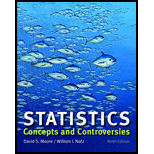
Concept explainers
(a)
The percentage of the overall population for each age group for the year 1950 and 2050.
(a)
Answer to Problem 20E
Solution: The percentage of the overall population for each age group for the year 1950 and 2050 are obtained as follows:
| Age Group | Population of 1950 | Percentage 1950 | Population of 2050 | Percentage 2050 |
| Under 10 years | 29.3 | 19.3911 | 56.2 | 18.0940 |
| 10 to 19 years | 21.8 | 14.4275 | 56.7 | 18.2550 |
| 20 to 29 years | 24.0 | 15.8835 | 56.2 | 18.0940 |
| 30 to 39 years | 22.8 | 15.0893 | 55.9 | 17.9974 |
| 40 to 49 years | 19.3 | 12.7730 | 52.8 | 16.9994 |
| 50 to 59 years | 15.5 | 10.2581 | 49.1 | 15.8081 |
| 60 to 69 years | 11.0 | 7.2799 | 45.0 | 14.4881 |
| 70 to 79 years | 5.5 | 3.6400 | 34.5 | 11.1075 |
| 80 to 89 years | 1.6 | 1.0589 | 23.7 | 7.6304 |
| 90 to 99 years | 0.1 | 0.0662 | 8.1 | 2.6079 |
| 100 years and over | 0.6 | 0.1932 |
Explanation of Solution
Calculation:
The percentage of the total population can be obtained by using the formula
The percentage of the total population can be calculated by using the Minitab software. The below steps are followed to obtained the required percentage for each age group for both the years.
Step 1: Enter the population for both the year 1950 and 2050.
Step 2: Go to Calc
Step 3: Enter the required expression in the “Expression” column and click on OK.
Step 4: Repeat the process for both the years.
The obtained result is shown in the below table:
| Age Group | Population of 1950 | Percentage 1950 | Population of 2050 | Percentage 2050 |
| Under 10 years | 29.3 | 19.3911 | 56.2 | 18.0940 |
| 10 to 19 years | 21.8 | 14.4275 | 56.7 | 18.2550 |
| 20 to 29 years | 24.0 | 15.8835 | 56.2 | 18.0940 |
| 30 to 39 years | 22.8 | 15.0893 | 55.9 | 17.9974 |
| 40 to 49 years | 19.3 | 12.7730 | 52.8 | 16.9994 |
| 50 to 59 years | 15.5 | 10.2581 | 49.1 | 15.8081 |
| 60 to 69 years | 11.0 | 7.2799 | 45.0 | 14.4881 |
| 70 to 79 years | 5.5 | 3.6400 | 34.5 | 11.1075 |
| 80 to 89 years | 1.6 | 1.0589 | 23.7 | 7.6304 |
| 90 to 99 years | 0.1 | 0.0662 | 8.1 | 2.6079 |
| 100 years and over | 0.6 | 0.1932 |
(b)
To graph: The histogram for the percentage of the population of the year 1950.
(b)
Explanation of Solution
Graph: To obtain the histogram for the obtained result in previous part, Excel is used. The below steps are followed to obtain the required histogram.
Step 1: The data is entered in the Excel worksheet. The snapshot of the obtained table is shown below:
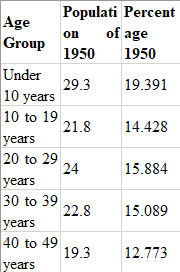
Step 2: Select the data set and go to insert and select the option of cluster column under the Recommended Charts. The screenshot is shown below:
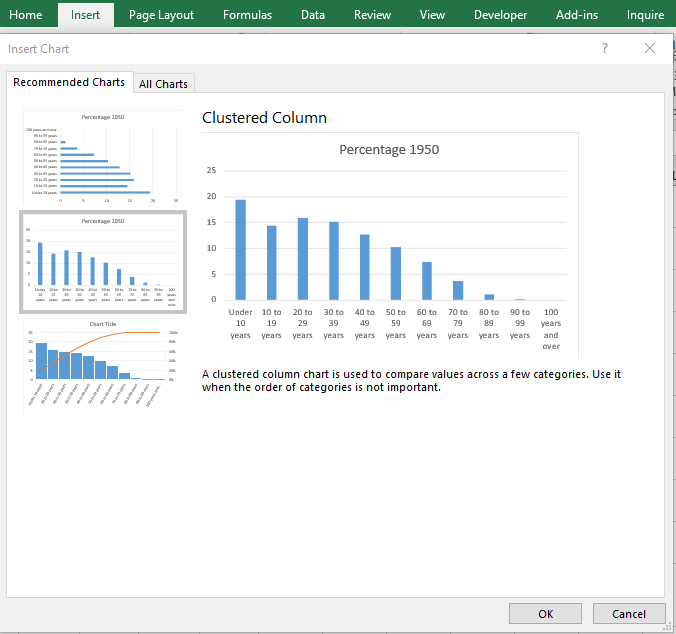
Step 3: Click on OK. The diagram is obtained as follows:
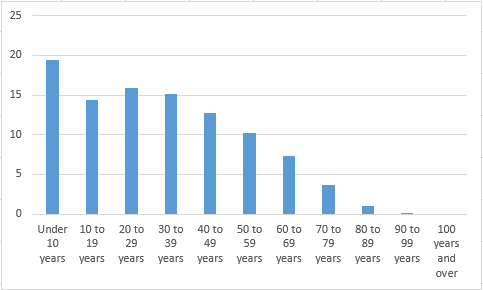
Step 4: Click on the chart area and select the option of “Primary Horizontal” and “Primary Vertical” axis under the “Add Chart Element” to add the axis title. The screenshot is shown below:
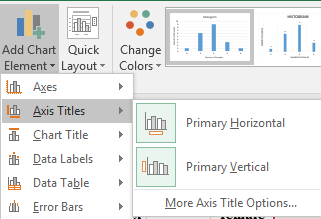
Step 5: Click on the bars of the diagrams and reduce the gap width to zero under the “Format Data Series” tab. The screenshot is shown below:
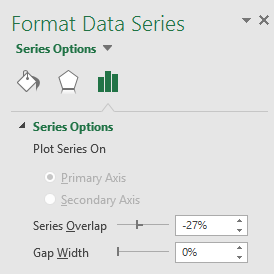
The obtained histogram is as follows:
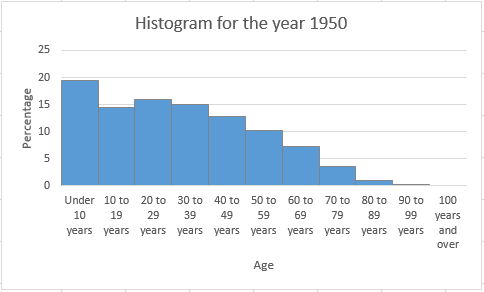
To explain: The key features of the age distribution.
Answer to Problem 20E
Solution: The age distribution is right-skewed.
Explanation of Solution
(c)
To graph: The histogram for the percentage of the population of the year 2050.
(c)
Explanation of Solution
Graph: To obtain the histogram for the obtained result in previous part, Excel is used. The below steps are followed to obtain the required histogram.
Step 1: The data is entered in the Excel worksheet. The snapshot of the obtained table is shown below:
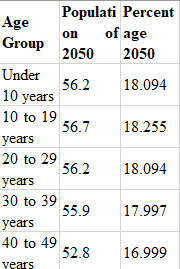
Step 2: Select the data set and go to insert and select the option of cluster column under the Recommended Charts. The screenshot is shown below:
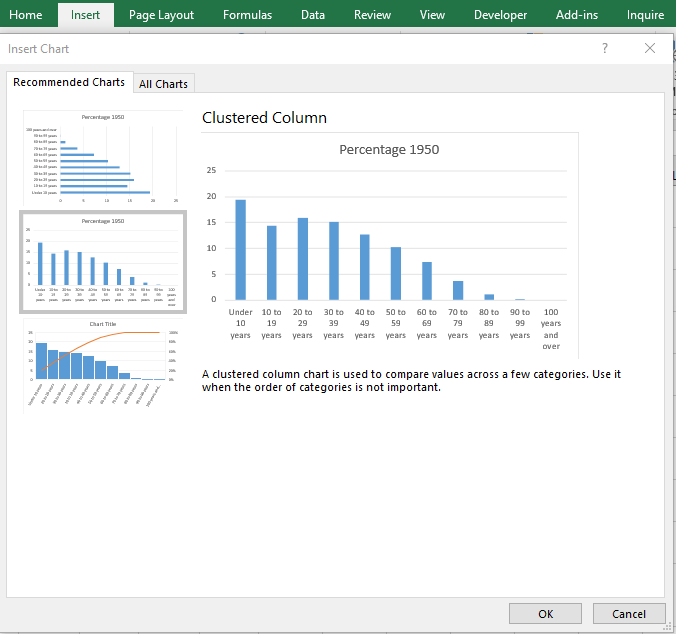
Step 3: Click on OK. The diagram is obtained as follows:
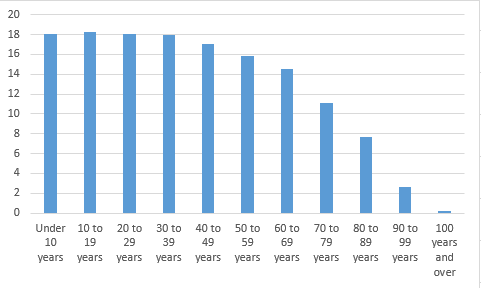
Step 4: Click on the chart area and select the option of “Primary Horizontal” and “Primary Vertical” axis under the “Add Chart Element” to add the axis title. The screenshot is shown below:
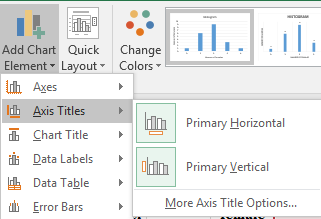
Step 5: Click on the bars of the diagrams and reduce the gap width to zero under the “Format Data Series” tab. The screenshot is shown below:
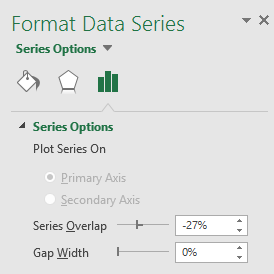
The obtained histogram is as follows:
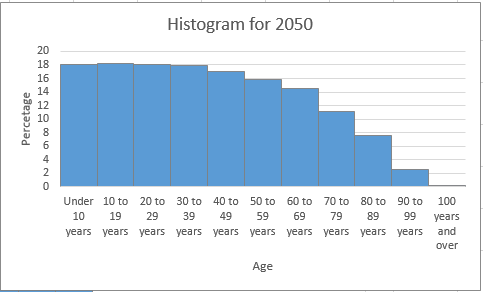
Interpretation: The histogram for the age distribution of the year 2050 shows that percentage of the age groups from under 10 years to 30–39 years are almost equal.
The change between the age distribution of the year 1950 and 2050.
Answer to Problem 20E
Solution: The main change between the age distribution of the year 1950 and the year 2050 is the amount of the skewness.
Explanation of Solution
Want to see more full solutions like this?
Chapter 11 Solutions
Statistics: Concepts and Controversies
- Name Harvard University California Institute of Technology Massachusetts Institute of Technology Stanford University Princeton University University of Cambridge University of Oxford University of California, Berkeley Imperial College London Yale University University of California, Los Angeles University of Chicago Johns Hopkins University Cornell University ETH Zurich University of Michigan University of Toronto Columbia University University of Pennsylvania Carnegie Mellon University University of Hong Kong University College London University of Washington Duke University Northwestern University University of Tokyo Georgia Institute of Technology Pohang University of Science and Technology University of California, Santa Barbara University of British Columbia University of North Carolina at Chapel Hill University of California, San Diego University of Illinois at Urbana-Champaign National University of Singapore…arrow_forwardA company found that the daily sales revenue of its flagship product follows a normal distribution with a mean of $4500 and a standard deviation of $450. The company defines a "high-sales day" that is, any day with sales exceeding $4800. please provide a step by step on how to get the answers in excel Q: What percentage of days can the company expect to have "high-sales days" or sales greater than $4800? Q: What is the sales revenue threshold for the bottom 10% of days? (please note that 10% refers to the probability/area under bell curve towards the lower tail of bell curve) Provide answers in the yellow cellsarrow_forwardFind the critical value for a left-tailed test using the F distribution with a 0.025, degrees of freedom in the numerator=12, and degrees of freedom in the denominator = 50. A portion of the table of critical values of the F-distribution is provided. Click the icon to view the partial table of critical values of the F-distribution. What is the critical value? (Round to two decimal places as needed.)arrow_forward
- A retail store manager claims that the average daily sales of the store are $1,500. You aim to test whether the actual average daily sales differ significantly from this claimed value. You can provide your answer by inserting a text box and the answer must include: Null hypothesis, Alternative hypothesis, Show answer (output table/summary table), and Conclusion based on the P value. Showing the calculation is a must. If calculation is missing,so please provide a step by step on the answers Numerical answers in the yellow cellsarrow_forwardShow all workarrow_forwardShow all workarrow_forward
 MATLAB: An Introduction with ApplicationsStatisticsISBN:9781119256830Author:Amos GilatPublisher:John Wiley & Sons Inc
MATLAB: An Introduction with ApplicationsStatisticsISBN:9781119256830Author:Amos GilatPublisher:John Wiley & Sons Inc Probability and Statistics for Engineering and th...StatisticsISBN:9781305251809Author:Jay L. DevorePublisher:Cengage Learning
Probability and Statistics for Engineering and th...StatisticsISBN:9781305251809Author:Jay L. DevorePublisher:Cengage Learning Statistics for The Behavioral Sciences (MindTap C...StatisticsISBN:9781305504912Author:Frederick J Gravetter, Larry B. WallnauPublisher:Cengage Learning
Statistics for The Behavioral Sciences (MindTap C...StatisticsISBN:9781305504912Author:Frederick J Gravetter, Larry B. WallnauPublisher:Cengage Learning Elementary Statistics: Picturing the World (7th E...StatisticsISBN:9780134683416Author:Ron Larson, Betsy FarberPublisher:PEARSON
Elementary Statistics: Picturing the World (7th E...StatisticsISBN:9780134683416Author:Ron Larson, Betsy FarberPublisher:PEARSON The Basic Practice of StatisticsStatisticsISBN:9781319042578Author:David S. Moore, William I. Notz, Michael A. FlignerPublisher:W. H. Freeman
The Basic Practice of StatisticsStatisticsISBN:9781319042578Author:David S. Moore, William I. Notz, Michael A. FlignerPublisher:W. H. Freeman Introduction to the Practice of StatisticsStatisticsISBN:9781319013387Author:David S. Moore, George P. McCabe, Bruce A. CraigPublisher:W. H. Freeman
Introduction to the Practice of StatisticsStatisticsISBN:9781319013387Author:David S. Moore, George P. McCabe, Bruce A. CraigPublisher:W. H. Freeman





